What we all learn through parenting is that there are so many things that will happen which we never have expected. For me, that was my baby refusing the bottle.
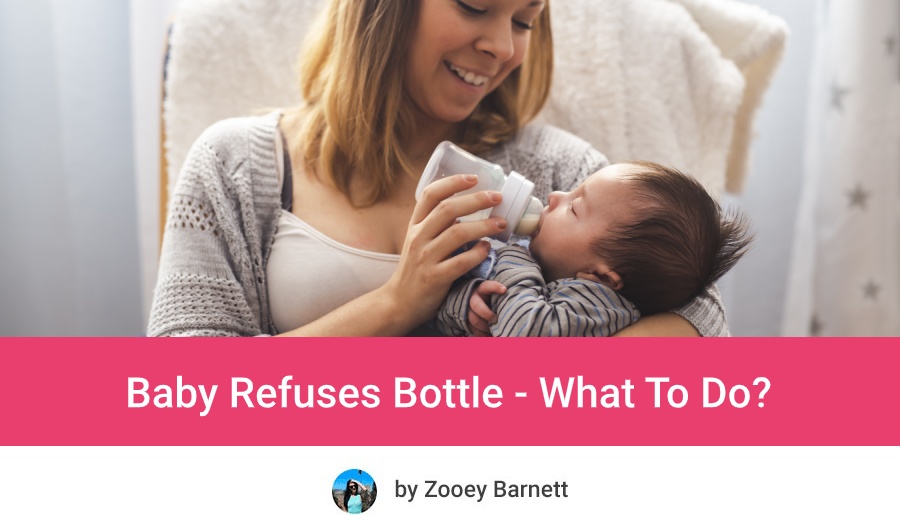
This article is NOT a substitute for medical advice or care
Before I became mother for the first time I was convinced I want to breastfeed exclusively and I was so excited about it. Then when my baby was 3 months old we needed to introduce the bottle.
I still remember how stressed I felt when I realized “my baby won’t take a bottle”. I had to go back to work earlier than I planned and this whole situation was really overwhelming.
I did the most natural thing – I panicked.
Luckily, with a lot of help from my husband and my mom, extensive research, and some trail and error with couple of baby bottles, we finally get our baby girl to take the bottle. And after few weeks she got used to switching back and forth from breast to bottle, without nipple confusion.
To save you some time (I know your short on that), this is what I have learned from my research and experience – both personal and shared by other moms.
Why My Baby Refuses The Bottle?
Before we dive into some tips how to get a breastfeeding baby to take a bottle, first we need to learn more about bottle refusal. Why do babies refuse the bottle?
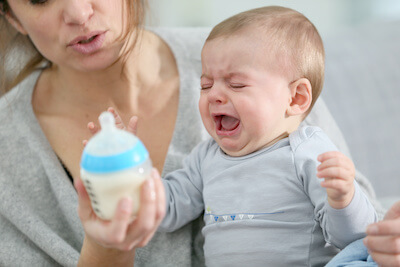
Bottle refusal can be very tough on parents. That troubling thought “Am I doing something wrong?” is what we all experience.
But blaming yourself is never the answer because the problem isn’t you. This is something that I had to explain to myself so many times. Babies are just as complicated as we are and there can be many reasons why your baby won’t take a bottle.
You may feel confused or desperate because you don’t know what to do. I’ve been there too. It’s a tough situation to face but it’s not as hopeless as it seems right now.
To understand what bottle refusal is, you need to understand that the causes can be different.
If your pediatrician rules out medical conditions that could cause bottle refusal, it’s probably the bottle-feeding itself that causes the problem. Check the possible reasons for bottle refusal – this may help you to solve this issue even quicker than you think.
The Most Likely Reasons Why Babies Are Refusing Bottles
If there are no medical reasons for the baby to refuse the bottle, it might simply mean that your baby just needs some time to get accustomed to a new source of food.
- The artificial nipple feels weird in the mouth and they simply don’t like it.
The sign of that may be spiting the bottle nipple the second it touches baby’s mouth. In many cases baby refuses pacifiers too.
- They associate the bottle with a negative experience.
The sign of that may be that baby suddenly stops taking the bottle. There are many situations that for the baby may feel as negative experience:
-
- The flow was too fast and baby was choking with the milk
- Throwing up while taking the bottle
- Associating the bottle with someone who gave them the bottle and it was a negative’s experience (for example if older sibling is giving the baby the bottle and keeps taking it in and out of baby’s mouth which frustrates the baby)
- A baby that is just learning to breastfeed can be confused with a sudden change to a bottle.
It’s best to introduce the bottle when the breastfeeding is well established (around a month), but this will of course depend on your milk supply and willingness to breastfeed.
- The bottle you’re using is not right for your baby
Bottles may demand different sucking action, and if you’re using wrong bottle (like if the nipple flow doesn’t meet your baby’s needs and preferences) – the bottle-feeding may become negative experience for the baby.
Baby may struggle to suck the milk from the bottle, swallow too much air during the feeding.
If the bottle causes colic, reflux or other tummy pains, there’s possibility that your baby won’t take bottle.
Although if your baby is older and you have well established breastfeeding, it’s unlikely that the bottle is too difficult for the baby, because the milk flows easier from it so latching on it is actually easier.
However, if you choose a bottle with a nipple shape or nipple flow that doesn’t suit your baby’s preferences and latching capabilities they may refuse the bottle. It may be more common for baby’s who were not breastfed.
Getting the right bottle may help to get a breastfeeding baby to take a bottle.
- You’re feeding your little one in a place that is not feeding-friendly
It should be a quiet, distraction-free environment, especially when you’re introducing the bottle for the first time.
- They are used to breastfeeding satisfying their hunger and don’t want to accept any substitute
If babies associate eating with mom, any substitute won’t be satisfying for them.
If you ruled out other reasons, this is probably the case. It’s the most common reason for bottle refusal in breastfeeding babies.
What Do You Do If Your Baby Won’t Take A Bottle?
Here we are! It’s time for practical tips for parents whose children are refusing the bottle.
#1 Remember that you’re not alone!
Lots of parents struggles to get their baby to take the bottle. Try to stay calm and patient – if your baby is healthy and hungry, he/she will finally take the bottle, you just need to be consistent.
Remember that babies are really good at sensing mom’s emotions and mood, especially when she’s stressed and panicking. And they don’t like to be forced.
So try to relax. If you try to transition your baby from breast to bottle, and your little one didn’t take the bottle today, you can always try to introduce it tomorrow.

#2 Try pace-feeding
One of the most important things about bottle-feeding is that it should mimic breastfeeding as much as possible. This means that you try to:
- Feed your baby on demand and not by the clock – If the baby is hungry he/she may be more willing to take the bottle. But don’t wait too long – super hungry baby may be too fussy and angry.
- Feed in more upright position – Usually the milk flows faster from the bottle than from the breast, so if you try the semi-upright or upright position it will slow down the feed. It will be more comfortable for the baby. This position will also help to reduce gas and decrease the risk of ear infections (which are related to flat-out bottle-feeding position).
- Nipple tickle – don’t force the baby to latch on the nipple, let them to take the lead. Just bring the bottle nipple to baby’s nose and put it gently on baby’s mouth to encourage them to latch.
- Switch sides – When you breastfeed you switch sides right? Try to do the same when bottle-feeding halfway through the bottle. This may help the baby to accept the bottle. Besides, it has other advantages too: the baby can see you from different perspectives!
- Slow it down – It’s harder for babies to extract the milk from the breast, besides the breastmilk flows more slowly. On the other hand bottles nipple flow may be too fast (which may lead to overeating, gas and that awful colic). Make sure to choose the right nipple flow – accordingly to your baby’s age and feeding needs, as well as try to take some breaks during the feeding.
#3 Try bottle-feeding skin to skin.
That closeness can soothe the baby and resemble the breastfeeding position.
#4 Let your baby know that the milk is coming
Put a drop of milk on their lips so that they sense what the bottle will bring to them.
#5 Try some distractions
Experiment with relaxing distractions such as singing, rocking, or walking around with your baby in your arms
Tips For Parents: How To Get A Breastfeeding Baby To Take A Bottle
Switching from breastfeeding to bottle feeding is a common situation when babies refuse the bottle.
Here are some tips that can help babies to accept the bottle:
#1 Start early
If you’re reading because you’re looking for some help to get your baby to take the bottle, it’s probably too late for this advice. But if you’re here learning about bottle refusal in advance or plan on having more kids in the future, this may be useful for you too.
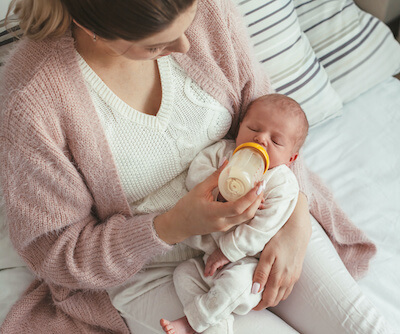
Even if you plan on exclusive breastfeeding, like I did, introduce the bottle early, to ensure that your baby keeps their option open to the bottle. Just to have a peace of mind in case of emergency when you won’t be able to offer the baby your breast, or when you need to take a break.
Most expert say it’s best to wait until the baby is 3-4 weeks and the breastfeeding is well established. Around a month baby should be latching well on your breast. For other babies it may be around 6 weeks.
Just keep in mind that if you want to keep breastfeeding as your primary feeding method, give the bottle consistently but only once a day.
Obviously, if you want to exclusively bottle-feed your newborn baby you should introduce the bottle right after the birth.
#2 Have someone else to feed the baby
If the baby can see and sniff you, he/she will obviously prefer you and your breast! Get your partner or other family members to give the bottle. It’s best to have someone who has some experience with this (I used my mom expertise).
Bottle-feeding may be the perfect opportunity for other family members to bond with the baby.
One more tip: go to another room or go for a short walk around the house, so the baby won’t see, hear and smell you, to avoid sabotaging someone else’s attempt.
But keep in mind that during the first bottle experiments it’s best if you stay close, for example in another room. Some moms also recommend to give the feeding person piece of your clothing that smells like you.

#3 Choose a quiet place
Whether it’s you or someone else trying to offer the bottle, choose quiet location with no distractions and unwanted noises that could bother the baby.
Go to that place for a few minutes before feeding, so the baby could get familiar with it and relax (you can also rock or sway the baby for a few minutes). Once the baby is calm and relaxed, give them the bottle.
Some moms recommend to feed in the same place as if you were breastfeeding, some recommend to use completely different place, walking around the house or even to go outside if the weather is good.
For instance some babies finally accept their bottles when they are focused or mesmerized by something that is really interesting to them like the leaves on the trees1.
You need to find location that will work for your baby.
#4 Find the perfect time
It’s best to offer the bottle when the baby is hungry enough but not starving. If the baby is really hungry, he/she may be fussy and the chances that he/she accepts the bottle are low.
On the other hand, don’t introduce the bottle when the baby is not hungry at all, because they won’t have motivation to take it. For me it took some time and experimenting to find the perfect time frame.
One more thing, choose the right time during the day when the baby is calm and patient, not fussy or exhausted.
#5 Try different positions
Some moms recommend to hold the baby in the same position as if you were nursing.
On the other hand, since the milk flows faster from the bottle, for many kids semi-upright position may be more convenient. Experiment a little bit to find the most comfy position for your little one.
Keep in mind that fully horizontal position won’t be comfy for the infant and may lead to winds or ear infection.
#6 Serve warm milk
If you’re using your breastmilk it’s a good idea to use freshly pumped milk, when you want to introduce the bottle. It will have the perfect temperature for the breastfed baby. Besides, fresh breastmilk will have familiar taste for the baby.
If the milk was in the fridge, it may have a bit different taste (because of lipase – the enzyme that breaks down the fat in breast milk; if it’s broken down too much, the taste of milk may be changed).
If you need to use the milk from your fridge stash or formula, warm it up to body temperature (around 98°F). Make sure to test it on your wrist before serving.
#7 Warm the nipple
Especially if you kept the bottle in the fridge, hold it under warm water to make the nipple warmer and more acceptable for your little one.
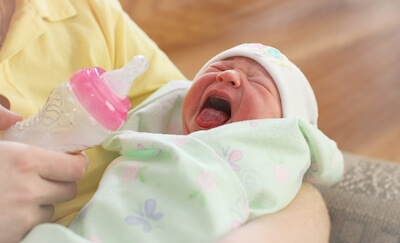
#8 Check if your bottle works properly
Is your bottle teat at correct size for your baby’s age and stage? Babies also have different preferences, that often depend on mom’s nipple size, if they were nursing.
Moreover, always careful screw the bottle lid/ring to prevent milk from leaking out, which could be an unpleasant and negative experience for the baby.
Keep in mind that if the ring is screwed on too tightly, it may be difficult for the baby to suck the milk out of it.
#9 Test different bottles
If it seems like the bottle doesn’t suit your baby, trying different one (or even a few) may help. You may want to try a bottle with different shape, made of a different material, with different nipple shape and feel.
Although this may seem like an obvious solution for some parents, I didn’t make this my no. 1 tip. Why?
Because it’s better to test the free methods first, with the bottle you’ve already had, before you spend more money on different bottles.
Anyway, if you feel like the bottle is the problem, check out my favorite bottles for breastfed babies. I created this list with babies who refuse bottle in mind. 🙂
#10 Try different nipple flow
It should be chosen accordingly to your baby’s age, feeding needs, swallowing capabilities and preferences.
Usually newborn babies and young infants need slow flow, while older babies need faster flow. Keep in mind that if the flow is too slow, it may frustrate the baby as he/she will struggle a lot to get the milk and swallow a lot of air instead of milk.
Too fast flow is not good either because even if your baby seems to prefer it, it may lead to overeating and easily cause choking! At the beginning, you may also try to find a bottle nipple that has a similar flow to your nipple.
#11 Be consistent and don’t give up
If you want to have a plan B, in case you won’t be able to breastfed, try to include 1 bottle each day in your feeding schedule.
#12 Don’t force
This is one of the biggest mistakes that you could make!
Don’t force the bottle into your baby’s mouth. Start it gently and let the baby to lead. Touch their lips or chin with the bottle nipple and wait for the baby to open mouth for it. Let your baby to such the nipple for 30 – 60 seconds before the milk starts to flow (the same way your breasts work).
Carefully observe your baby for signs of struggling. If your baby turns the head away, spits the nipple out or the milk is spilling out of their mouth, take a break.
Tip the bottle so the milk stops flowing and wait as the baby is willing to suck it again. Always keep the bottle at an angle that allows to fill the nipple so the baby could control when and how fast the milk flows2.
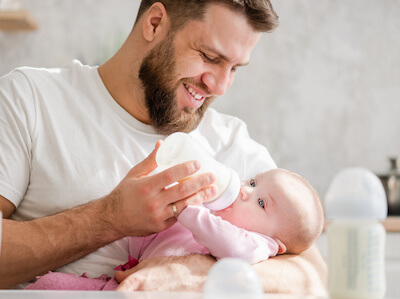
Help! My Bottle-Fed Baby Suddenly Refuses Bottle
Here’s another frustrating form of bottle refusal. Your baby might have been bottle feeding without any problem for some time and then suddenly he/she stopped.
If you are in this situation as well, here is what might help:
- This may be just a phase of refusing bottle. Ask someone else to feed the baby, until this phase passes. Don’t force it.
- Consider changing the nipple. Are you using the right flow for your baby’s age, needs and preferences?
- Change the temperature of the milk. Some babies prefer room temperature milk while others like when it’s warmer.
- Loosen the cap of the bottle a tiny bit to see if it had been creating a vacuum and making it hard for your baby to suck on it.
- Regularly check your equipment, the bottle and nipples, for any damages or signs of wear. Get a new bottle in case your little one overused the old one.
- Your baby may be fussy because he/she demonstrates other needs like tiredness or discomfort (caused by wind, colic, feeling too hot/cold, the need to burp).
- Your baby might have had a negative experience with a bottle (like throwing up while taking a bottle, choking, or milk spilled out on their face). Make sure that your baby is not experiencing any of this.
- Check the expiry date on the powdered formula and also make sure that it isn’t open more than recommended.
- Eliminate all distractions. There might be some change in the environment that is distracting the baby from the feeding (you started turning on the TV during feeding, your relatives are staying in the house, etc.)
- Slow down the feeding by pausing for breaks.
- If a baby started to eat solid foods, he/she might be full or less interested in milk.
- Check for the signs of thrush3, throat or ear infection, gum infection, or any other illness. Babies may be refusing the bottle because they are not feeling well. Consult with your pediatrician to rule out medical reasons.
Do Babies Refuse Bottles When Teething?
Babies grow fast and before you’ll know it, you’ll notice that your baby’s soft gums are starting to change.

When the teething comes along, there might be some changes in your baby’s behavior towards the bottle. Some babies tend to want to bottle-feed more when teething as they have the urge to suck. Others will be less tempted to take the bottle.
Teething can come with great pain which can lower your baby’s desire for food. If you notice that your baby is starting to refuse the bottle when teething, ask your pediatrician if you can add milk or some water to their purees (if your baby is old enough to eat it).
Teething can also be a signal that it’s time to think about bottle weaning. Generally speaking, bottles are bad for toddler’s teeth. A baby that uses a bottle after the age of one has more chances to experience tooth decay, misaligned teeth, and even damaged adult teeth.
How to Bottle Feed a Baby – General Rules
Having some useful information on bottle-feeding is always a good idea. Your baby will probably have to take a bottle sooner or later, even if it’s just a few times.
Maybe you want to pump exclusively, or your baby is transitioning from breastfeeding to bottle-feeding because you have to go back to work. Or, maybe you don’t have enough milk supply and you have to supplement with formula. Or you may be separated from the baby for a while and you want to learn your baby to accept the bottle “just in case”.
In all cases, you need to introduce the bottle to your little one. Here’s some general information about it:
- Make sure that all your bottle-feeding equipment is always clean, that includes the cleaning brushes and washing bin too. Check the bottles and nipples frequently for any signs of wear and replace them when needed.
- Always prepare the formula accordingly to the manufacturer’s directions to prevent dehydration, diarrhea, or improper nutrition, and store it properly. If you’re bottle-feeding your baby with breastmilk, follow these rules for safe storage and preparation.
- If the milk/formula has been refrigerated warm it at least to room temperature or body temperature. Most babies like their milk lukewarm or warm.
- Don’t feed your little one when he/she is laying on their back, because the formula/milk may flow into the middle ear, leading to ear infection. Semi-upright position is usually better, and allows to keep air from baby’s belly, reducing gas and reflux. Just like during breastfeeding, switch sides when bottle-feeding.
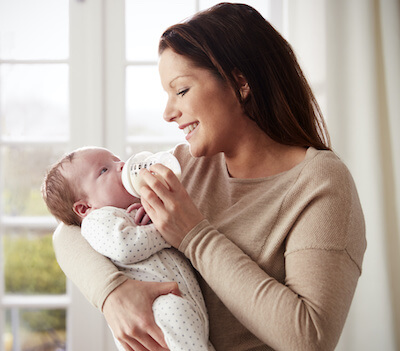
- Take notes how much your baby is eating. This may be very useful when you consult with your pediatrician. Don’t force the baby to finish bottle, if he/she seem not interested in it. If the bottle is empty but your baby sucks the nipple enthusiastically, you may offer more milk/formula.
- Burp the baby – both bottle-fed and breast-fed babies may swallow air during feeding. That’s why it’s important to burp the baby every 2-3 ounces, to keep the air from their tummy.
- Bottle-feed the baby using pace feeding method – this means following baby’s cues and allowing for breaks. This helps the baby learn to regulate their hunger accordingly to their natural schedule and biorhythm which gives them ample time for digestion. It means that the baby doesn’t have to eat the same amount each time during the day.
- The bottle needs to be at a horizontal angle – the baby should be able to work to suck the milk/formula from the bottle, instead of milk flowing fast from the bottle and dripping into baby’s mouth.
- Give the baby breaks by leaning the bottle back (not pulling it suddenly away from their mouth). Offer more milk if the baby is still interested.
- Burp the baby mid-feed to prevent gassiness and fussiness.
Baby Won’t Take Bottle – Be Patient, Keep Trying & Experiment
Changing from breastfeeding to bottle feeding is a big step for both us moms and our little ones. When your child refuses the bottle the journey of stress and impatience comes.
What you can tell from all of this is that there is a solution to everything and bottle refusal is no exception. Getting your child to take a bottle will be emotionally exhausting but you have to persistent. Remember that you are not alone in this and many of us have gone through the same thing.
The purpose of this article is informative. It’s not a substitute for medical consultation or medical care. Remember: safety first! Consult your doctor/pediatrician in case of any doubts. The author of this article does not accept any responsibility for any liability, loss or risk, personal or otherwise, incurred as a consequence, directly or indirectly, from any information or advice contained here.

